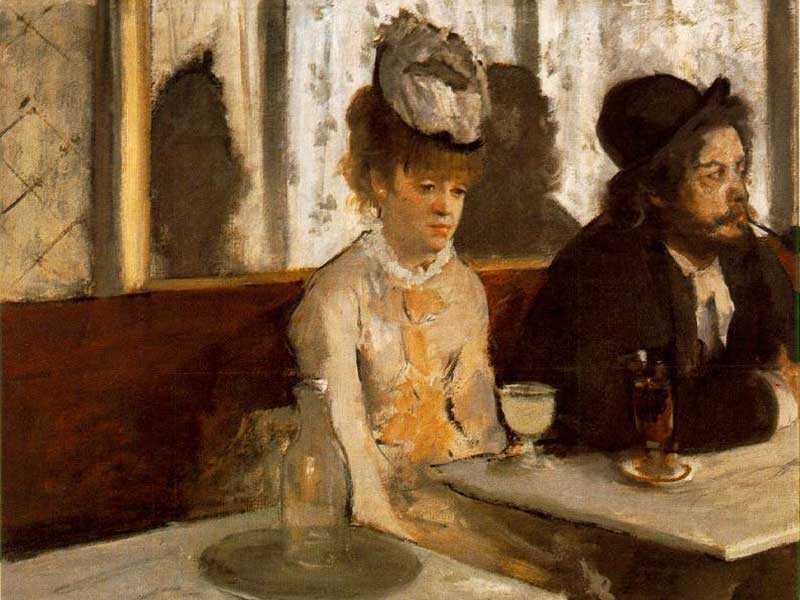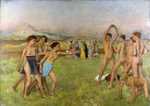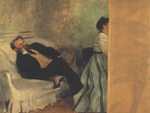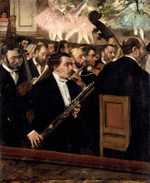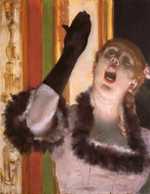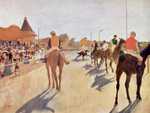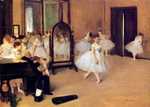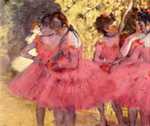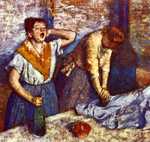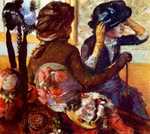1. Degas early years
Edgar Degas was born on 19 July 1834 at 8, Rue Saint Georges in Paris. He was the eldest of his parents' five children
Degas’ father, Augustin, was a wealthy banker and his mother a Creole emigre from New Orleans. Degas attended a good Lycee and graduated with a baccalaureate in 1853. He then studied law for a while, but it became increasingly clear that art was his true vocation.
Unlike Monet, Degas’ father was a source of encouragement and advice. Degas enrolled at the Louvre as a copyist and spent large chunks of the 1850s in Italy, staying in Florence and Rome in particular, copying Renaissance masterpieces.
Degas’ early style
Degas’ early style might be said to be classical, and it is certainly true that he was inspired by Ingres and old masters such as Titian. But two aspects of Degas’ work suggested from an early age that he was destined for greatness.
First, Degas was a hard-worker. By 1860, he has produced 700 copies of older works.
Secondly, and more importantly, Degas did not copy works unthinkingly. He would, for example, focus on a small part of a masterpiece rather than seek to reproduce the whole. And Degas committed his thinking on painting, together with many of his innermost thoughts, to a meticulous diary.
Degas’ early works
Degas’ unique insight can be seen in three of his earliest works, The Suffering of New Orleans, Spartan Girls Challenging Boys and The Bellelli Family.
(1) The Suffering of New Orleansis ostensibly an historical painting in classical style. But it seeks to depict a modern event, the capture of New Orleans by Union Troops in 1862 (representing a major turning-point in the American Civil War).
Interesting fact
The result is decidedly odd: nude females lie around in agony, whilst another is shot by an archer on horseback. The only ostensible reference to New Orleans is what appears to be a fairly small fire to the top right of the painting. But these oddities don't much matter: the important thing is that Degas was thinking about his art and trying to be different.
Degas was disappointed when Suffering received scant attention during the 1865 Salon, where all other works were overshadowed by Manet’s Olympia (a painting of a naked prostitute staring brazenly out from the canvas). Competed in 1865, the Suffering now hangs in Paris’ Musee d’Orsay.
(2) Spartan Girls Challenging Boysis another fascinating work. Sparta was a warrior society in ancient Greece, and this painting shows a group of nude adolescent girls taunting a similar group of boys. But, again, the picture seems to add a touch of modernity: were the girls really from a Spartan age or were they, as one critic put it,
“skinny urban brats”.
Though substantially completed in 1860, Degas did not show this painting until the impressionist exhibition of 1879 and kept it in his studio throughout his life. It now hangs in London’s National Gallery.
(3) The Bellelli Familyis a family portrait with a difference.
The father, Baron Bellelli, is placed to the right of the picture and with his back to the viewer, as if to remove him from the family centre. The Bellelli’s younger daughter, Giulia, is pictured with her left leg tucked underneath her body in an informal stance that would be frowned upon by traditionalists. And the matriarch is pictured staring into space, as if she is biting her tongue. This is, then, an ambitious psychological work.
Painted between 1858 and 1869, The Bellelli Family now hangs in the Musee d’Orsay.
2. Degas and the Impressionists
Degas met Edouard Manet in 1862 and became a central figure in the impressionist movement.
He exhibited in seven of the eight impressionist exhibitions, and was often involved in their organisation.
Degas and Manet
Manet bumped into Degas when Degas was painting as a copyist in the Louvre in 1862. Legend has it that Manet made a quip about Degas etching directly only an engraving plate.
But the meeting was a turning point in Degas' career. Manet was fast becoming the leader of the avant-garde artistic movement in Paris, a position he cemented when his Olympia was accepted by the Salon in 1865 and caused uproar.
Manet and Degas became firm friends, frequently painting together and socialising with the rest of the impressionist group at the Cafe Guerbois. They were from the same social strata and were both-quick witted, though Degas was more acidic and uncompromising in his views.
Interesting fact
Their friendship endured, though it had its ups and downs. The nadir came when Degas painted Manet lying on a sofa listening to his wife playing the piano. Manet so objected to Degas' depiction of his wife's features that he slashed the painting (see the top picture).
When Degas learned what had happened he recovered the work and returned a Manet still-life that he had been given in return. The two men became friends again before too long, but the episode tells us a good deal about Manet's affection for his wife and the rivalry that existed between the two painters.
The Franco-Prussian war
Degas, like Manet, was a real patriot and volunteered for infantry service during the 1870/1 Franco-Prussian war. Manet did a similar thing, and Renoir and Bazille also joined up. By contrast, Monet left France with his wife and young son and spent war in London; and Cezanne his from the authorities in a small village outside of Aix-en-Provence.
During marksmanship training, a serious eye condition which was to afflict Degas greatly in later life was identified.
Bazille was the only impressionist to die during the war. But a communist Commune was declared over Paris in the aftermath of the war, which led to a bloody civil war.
Degas sensibly travelled to New Orleans via London and New York in 1872, where his uncle Michel Musson ran a cotton business. He painted some remarkable works, returning after five months in February 1873. He later said that he liked America but that
"The lack of opera is a real torment to me."
The 1874 Impressionist Exhibition
By late 1873, plans were being hatched by most of the leading impressionists to hold their own independent exhibition. They were fed up of being rejected by the Salon or ignored by reviewers. By the end of the year, they had incorporated the Société Anonyme Coopérative des Artistes, Peintres, Sculpteurs, Graveurs (the Anonymous Society of Artists, Painters, Sculptors and Engravers).
The first exhibition was to open in April 1874, with Degas exhibiting ten works. They included the colourfulA Carriage at the RacesandRehearsal of a Ballet on Stage. The reviews were generally hostile, though Degas escaped more lightly than many of the others (Cezanne was singled out for particular ridicule).
By way of example, the following 'notification' appeared in the Paris press shortly before the first exhibition drew to a close:
“There is an exhibition of the intransigents in the Boulevard des Capucines, or rather, you might say, of the lunatics, of which I have already given you a report. If you would like to be amused, and have a moment to spare, don’t miss it.”
The Later Impressionist Exhibitions
Degas went on to exhibit at all but one of the eight independent impressionist exhibitions. He typically chose works that showed off the variety of his paintings, includingThe Cotton Exchange at New Orleans(exhibited in 1876),Absinthe(1876) and the wonderfully namedMlle La La at the Circus Fernando(1879).
Degas' commitment to the independent exhibitions is remarkable given his testy character and his often-repeated criticisms of certain of the impressionists. He exhibited 24 works at the second exhibition in 1876 and 25 at the third exhibition the next year. He even helped organise some of the exhibitions. But, as the above quote shows, the other impressionists often found him "intolerable".
The Difficult Degas
Degas quarrelled with the other impressionists for a number of reasons.
First, he was primarily a portraitist and did not see the virtues of the en plein air (outdoor) landscape paintings of Monet, Renoir, Pissarro, Cezanne and others.
Degas once remarked:
"You know what I think of people who work out in the open. If I were the government I would have a special brigade of gendarmes to keep an eye on artists who paint landscapes from nature. Oh, I don't mean to kill anyone; just a little dose of bird-shot now and then as a warning."
Secondly, he did not have much in common with the other impressionists except for Manet (who refused to participate in the independent exhibitions), coming from a different social class.
Thirdly, he abhorred the term 'impressionist' and insisted that non-impressionists such as John-Louis Forain be able to participate in the independent exhibitions.
3. Ballerinas and Jockeys
Degas' most famous works are of jockeys and ballerinas.
Racehorses
Horseracing, a recent import from England, was something of a novelty in mid-19th century France. It was much encouraged by Emperor Napoleon III, who owned horses, was responsible for the construction of the Longchamp racecourse, and who even helped draw up the rules. Before long, the sport became a major attraction with thousands of Parisians flocking to the races.
They included Degas and Manet—on one occasion, Degas even drew Manet at Longchamp.
Degas' had a life-long fascination with horse-racing, though his most important paintings of this genre were produced between the early 1860s and the late 1870s. His works are fascinating because they often focus on events other than the race.
For example, Degas' most famous works include horses and their jockeys milling about inHorses in Front of the Stands(1866-68, pictured), a family and their dog enjoying a day out inA Carriage at the Races(1869-72) and the tension before the start of a race inGentleman's Race: Before the Start(1862).
This is more evidence of Degas being a free-thinker, willing to challenge the orthodoxy. That character trait is also noticeable in his works of the ballet.
Ballerinas
Degas' first love was painting. But his second loves were opera and the ballet. As noted above, opera was the thing he missed most about Paris during his five-month stint in New Orleans.
Degas was a season ticket holder at the Paris Opera, where the city's ballet also performed, and was allowed behind-the-scenes access unavailable to the general public.
Degas was therefore able to paint scenes of ballet rehearsals, ballet examinations, ballerinas practicing at the bar, and unusual views of the stage. On a number of occasions he painted the stage in the background, barely visible through the hubbub of the orchestra; on others, he painted the action on stage at the centre of his canvas but included bored ballerinas waiting in the wings.
Interesting fact
Degas did not seek to glamorise the ballet. Many of the dancers he paints are looking bored (Ballet Rehearsal), tired (Dancer in Repose) or doing things like scratching, stretching, drinking, chatting, putting their dresses on, fastening their pointe shoes or yawning!
The focus on rehearsals and examinations also highlights the laborious and monotonous life of a dancer. And many pictures emphasise the discipline imposed on dancers, who were usually from the working classes, with choreographers wielding large sticks with which they beat out the time.
Indeed, some pictures even hint at the fact that many ballerinas were sexually exploited. See, for instance, a top-hatted gentleman leering at a ballerina inDancers Backstage. Not that Degas had a particular affection for the ballerinas who made his name: he often referred to them as
"little monkey girls".
There was another reason Degas painted ballerinas: they sold well. This was important because the De Gas bank, the source of his family's wealth, failed in the early 1870s, meaning that Degas—for the first time in his life—had to be self-sufficient.
We have selected Degas' Dancing Class as one of our top 10 impressionist works.
4. Degas' Later Life
Degas' later life was not particularly happy: he never married; his eyesight failed; he became embroiled in an anti-Semitic scandal; and he became even more difficult.
Degas' later works
Degas continued to paint the ballet and the occasional jockey in his later years. But he also devoted substantial attention to new topics, including women doing the laundry, lady's hat shops and sculpture.
Degas' first laundry painting was completed in 1869, but by the turn of century he had finished 14 works on this topic (four in 1884 alone). The picturedWomen Ironing(1884) depicts the intensity of the work and the exhaustion it caused.
A more glamorous topic was the Milliner (a lady's hat shop). Degas was introduced to this subject by Mary Cassatt, the American impressionist with whom he struck up an unlikely friendship. She took him to hat shops and on occasion posed as his model, allowing him to produce ravishing works of fleeting moments of surprise or disappointment when a new hat is tried on. Overall, he painted 20 canvasses on this theme.
Degas and sculpture
After his death over 150 small sculptures were found in Degas' studio. This was a surprise: Degas had only once shown a sculpture, at the sixth impressionist exhibition held in 1881, and had attracted mixed reviews. For some, his Little Fourteen Year-Old Dancer was an "ideal of ugliness"; for others it represented a "sculptural revolution".
Interesting fact
Degas' lack of training in sculpture meant that his figures, supported on improvised frames, were always in risk of collapsing!
Degas' sculptures are predominantly of ballerinas and horses and are highly regarded today. The English sculptor Paul Tucker even rates him above Rodin.
Degas and nudes
Between the mid-1880s and 1905 Degas painted a series of nudes, his work becoming less detailed and more abstract as his eyesight deteriorated. They include two works entitledThe Tub(1885-6 and 1886) and another two calledWoman Combing her Hair(1888-90 and 1905).
Degas did not paint his women in classical positions, but doing everyday things like bathing. This left him open to the charge of voyeurism (even from friends such as George Moore).
But Degas did not care. As he said:
"My women are simple human beings, but honest: they are merely looking after their bodies. This one is washing her feet. It is as if one were watching through a keyhole."
Degas and marriage
Degas' views on marriage changed over the years. At the end of his time in New Orleans in 1872/3, he was quite attracted to the idea, writing:
"... a good woman. A few children of my own, would that be excessive? ... It's the right moment, just right".
But later on he expressed his opposition in sarcastic terms, noting that:
"I have perhaps too often considered woman as an animal."
Degas and the Dreyfus Affair
Despite having a number of Jewish friends, Degas revealed his anti-Semitic views during the Dreyfus Affair, a political scandal that rocked France in the late 19th and early 20th centuries.
What happened?
Evidence was discovered by a French spy showing that military secrets were being leaked to the Germans. The evidence was a ripped-up letter with handwriting said to resemble that of a Jewish artillery captain, Alfred Dreyfus. Dreyfus was quickly court-martialled and convicted, and sent to Devil's Island to serve his term of imprisonment. To make matters worse, evidence that another man was guilty was suppressed by the French army.
This led to a major schism in French society, between those who thought Dreyfus innocent and those who considered him guilty. Those falling into the latter category was often anti-Semitic, ignoring the overwhelming evidence in Dreyfus' favour and the lack of due process leading to his conviction.
This split was reflected in the impressionists. Monet, Pissarro and Emile Zola (a leading writer and supporter of the impressionist cause) were pro-Dreyfus. Renoir, Cezanne and Degas were anti.
But Degas was the most outspoken in his anti-Semitic views. When a model in Degas’ studio suggested that Dreyfus may not be guilty, Degas screamed at her
“you are Jewish … you are Jewish … get out”.
Degas also broke off long-standing relationships with his Jewish friends.
Degas' death
By 1901 Degas' eyesight was so bad that he could only work on large formats using broad strokes of chalk. By 1908 he was so blind that he could no longer draw.
In truth, Degas was by this stage bitter and misanthropic. He even said to those who coud stand his company that
"Death is all I think of."
But Degas still liked to get out into the Parisian streets.
He died on 27 September 1917 and is buried in the family grave in Montmartre cemetery. Degas requested that only a single statement be uttered at his grave:
"He very much loved drawing."
Degas resources
To take your knowledge to the next level, check out our resources page - you'll find recommendations for the best impressionist books, videos and gifts.




